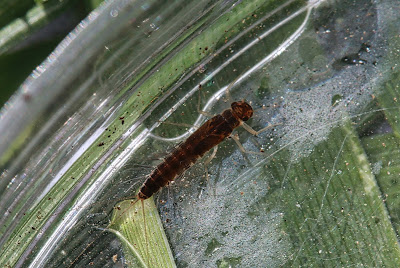I went up to the upper stretch of the Doyles River this morning -- just short of where it flows out of the Shenandoah National Park. I wasn't sure what I was going to find, but this one surprised me. It's a Pronggilled mayfly that I've found at the Rapidan River and in the small streams in Sugar Hollow. The upper Doyles -- in terms of size -- is somewhere in-between. Paraleptophlebia guttata.
I decided to work more on the ID using two sources. First, Unzicker and Carlson's article on "Ephemeroptera" in Aquatic Insects and Oligochaetes of North and South Carolina (pp. 3.59-3.60). In their key, item 2. is
Tracheae of gills with conspicuous lateral branches.......................3
Tracheae of gills without conspicuous lateral branches..................4
Pretty clear from the first photo above that we move on to 4. There we find
2nd and 3rd segments of each maxillary palp together 1.3 to 1.5 times the length of the 1st (basal) segment......................Paraleptophlebia guttata (McDunnough)
I measured -- no need to go further. The segments of the maxillary palps, like those of P. strigula, are all "elongate" (to use Don Chandler's term), and I found that with this nymph, segments 2. and 3. combined were 1.38 times as long as 1. Done.
But I also looked at Chandler's Key for the "Species of Leptophlebiidae," where after his description of the maxillary palps we find this.
8. Abdominal tergites largely dark, shining brown, with narrow pale submedian streaks at anterior margin; legs pale; length 7 mm; common in NH....................paraleptophlebia guttata
While my nymph only measured 6 mm, everything else is a match. Here's a good shot of those "narrow pale submedian streaks" on the tergites.
Very pleased with the quality of the photos that I got this morning.
__________________
But I'm learning some things. For example, 1) on my way out to the Doyles this morning I was pondering the difference between the pronggilled nymphs that have branched gills vs. those devoid of any branching. Could it be that the "branching" helps with the absorption of dissolved oxygen? That might mean that those with branched gills are slightly more tolerant than those without. After all, the species we find in the small, very clean streams in Sugar Hollow have gills that lack tracheal branching. Have to give up on that theory. Previously, the only pronggilled nymphs that I've seen in the Doyles River are those with tracheal branching. E.g., Paraleptophlebia sp. (mollis?)
and genus Leptophlebia.
But now we've got P. guttata in here as well.
2) Different pronggilled species seem to show up at different times. The Paraleptophlebia. sp. (mollis?) nymph in the picture above was found in the month of March, the Leptophlebia nymph in the month of December. No longer see either one. At the moment P. guttata's the only show in town. It appears to be a late spring/summer species.
And 3) while I thought P. guttata might be uncommon, I've been disabused of that idea. It seems to be plentiful in the Doyles -- i.e. "common" -- as it is in NH, at least this time of year.
__________________
So much to learn. so little time.







No comments:
Post a Comment